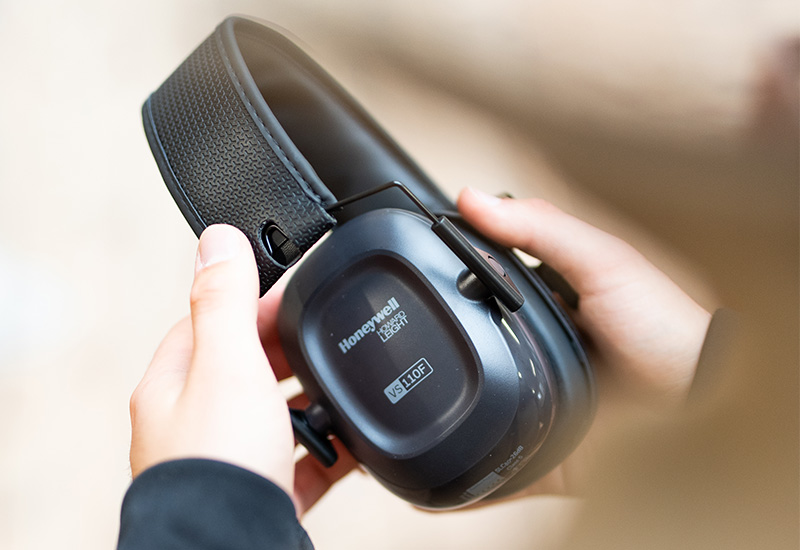
Hearing protection in the workplace
Employers failing to protect their employees‘ hearing risk high downtime costs and possibly even legal repercussions. So it’s high time we got to grips with this issue. Allow us to briefly summarise the most important facts so that in future you will know exactly what is important when it comes to occupational hearing protection.
When is hearing protection necessary at work?
There are very definitive values that determine whether hearing protection needs to be worn in a company. Two values are measured in this regard: the daily noise exposure level and the peak sound pressure level. These two somewhat cumbersome terms are roughly described as follows:
Daily noise exposure level:
How loud is the background noise generated throughout the working day? In other words, the volume of a continuous noise source such as running machines.
Peak sound pressure level:
How loud are noises of short duration? This relates to short-term noise such as gunshots or explosions.
Both have different limit values. Different regulations are applicable depending on the measurement results:
Daily noise exposure level < 80 dB
Peak sound pressure level < 135 dB
→ Hearing protection is not necessary.
Daily noise exposure level ≥ 80 dB
Peak sound pressure level ≥ 135 dB
→ Hearing protection is recommended.
Daily noise exposure level ≥ 85 dB
Peak sound pressure level ≥ 137 dB
→ Hearing protection is necessary above these values. Companies are required to provide employees with hearing protection, which they must also wear.
Mandatory hearing protection: what else is included?
Put on ear defenders and you’re done? Efficient hearing protection involves somewhat more than that and that is why there are additional regulations. Companies must implement the following measures on top of the actual protection:
- Operating instructions
These instructions contain all the important information summarising how to wear hearing protection safely in the respective company. - Briefings
Employees are briefed on how to use hearing protection correctly before wearing it for the first time and at least once a year thereafter. - Preventive check-ups
The „Noise“ occupational health check-up is mandatory at all companies in which hearing protection is prescribed. - Checks
Employers must check whether their employees are wearing hearing protection in accordance with the regulations.
Which is the right hearing protection?
When selecting the right hearing protection, two factors play an important role: the work situation and what the person wearing the hearing protection prefers. Should the hearing protection be uncomfortable or pinch, employees will probably not use it and take an unnecessary risk.
There are essentially three different variants: earplugs, ear defenders and earmoulds. The latter can be individually customised so that they provide a perfect fit and can be adjusted very precisely to suit the work application. They are, however, quite time-consuming and expensive when it comes to purchasing. More information can be found here.
Ear defenders are fairly easy to work with. That said, it can be difficult to combine them with other PPE such as helmets or goggles. Furthermore, some people perspire under the muffs and find this uncomfortable.
It’s practically the other way round with earplugs: you have to learn how to use them a little to get them to fit properly. On the other hand, they can be easily combined with other PPE and perspiration is virtually impossible or hardly noticeable. Very sensitive or small ear canals, however, may experience an annoying sensation of pressure.
In other words, there’s no perfect answer to this question to suit everyone. When in doubt, try out several options to find the most suitable protection.
Modern technology has made it possible to equip all variants with different filters and functions. This means you can customise the hearing protection to suit your specific application.
Which insulation level is correct?
Correct hearing protection is adapted to the respective work situation. The daily noise exposure level and the peak sound pressure level act as starting values. Subtract the insulation values of the hearing protectors you intend to use from this. The best-case scenario is to achieve a healthy value. The following information is given for the two measured values:
Daily noise exposure level: between 70 and 80 dB
Peak sound pressure level: under 135 dB
Yet caution is advised! The insulation values are determined under optimum laboratory conditions, which are rarely achieved in practice. The German Social Accident Insurance (DGUV) therefore recommends subtracting the following values from the insulation values:
- 9 dB for mouldable earplugs
- 5 dB for ear defenders, banded earplugs and pre-moulded earplugs
- 3 dB dB for earmoulds
Can hearing protection be too strong?
Yes, it’s possible to have too much hearing protection. We then speak of overprotection or „overinsulation“. When this happens, the hearing protection reduces the ambient noise too much. Consequently, the person wearing the hearing protection may hear other sounds less well or not at all. Warning signals or approaching vehicles are harder to hear and therefore constitute a risk. Similarly, communication at the workplace can be made unnecessarily difficult.
Hearing protection is PPE category III – why is this?
Hardness of hearing induced by noise is damage to the hearing that is almost impossible to heal. This is why hearing protection has been categorised as category III in the classification of personal protective equipment (PPE) since 2019.
This categorisation requires, among other things, that companies provide their employees with regular briefings. Employees can gain confidence in using hearing protection through regular training and exercises. This results in fewer errors and better hearing protection.
And that was just the beginning …
We have summarised the most important information regarding hearing protection in everyday working life in this article. Since there’s plenty more to learn, it’s best to take a look at our brochure. You’ll also find further information about the topics already mentioned, as well as much more about our hearing and how to protect it properly.